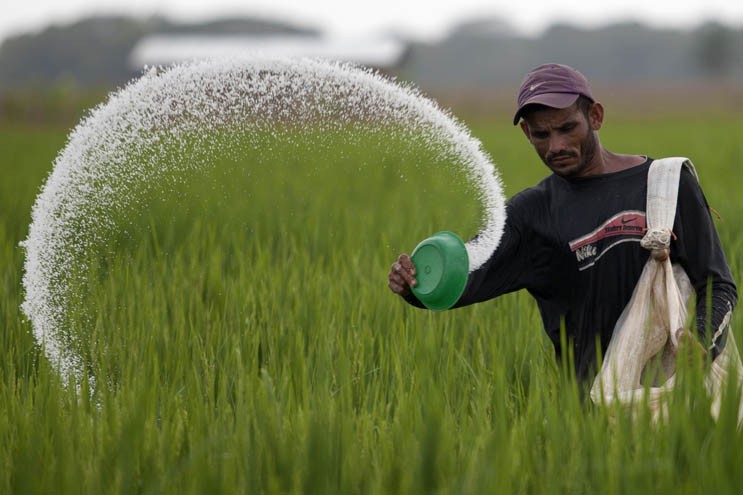
The prime minister’s relief package is subsidisation of big industry and landed elite in the name of agriculture and small farmers

Amid unrest among small farmers in the country, a few days back Prime Minister Nawaz Sharif has announced a relief package of Rs341 billion that includes different direct and indirect incentives to boost agriculture sector. About Rs20 billion will be paid directly to small-to-medium sized (12.5 acre) rice and cotton growers at 5000 per acres. Remaining portion of the package will go in subsidy on agricultural machinery, agricultural loans/credits fertilizers and establishing meat processing unit.
Mechanisation of agricultural is promoted in the name of increasing productivity, efficiency and modernisation thus subsidy is seen as a path towards success. It is not that simpler as it appears to be. Subsidisation is usually implemented in the form of reducing import duties and different taxes etc. Globally small farmers are subsistence-oriented and they can rarely manage high capital investment required to buy subsidised tractors and harvesters etc. Eventually these subsidies end up in the hands of large farmers who have enough social and finance capital to make such large investment.
Mechanisation helps large farmers to consolidate their holdings. In 1970s, the government’s subsidisation of agricultural machinery resulted in favouring large farmers. Subsequently, they could rely on machinery instead of human labour and hence resulted in exodus of landless and tenant labourer from rural areas to urban areas. For instance, tenant-operated area reduced from 46 per cent to 26 per cent from 1960s to 1990s, sharecropping farms were also reduced from 30 per cent to 16 per cent while average size of largest holding increased.
Apart from machinery, the prime minister also announced a subsidy of Rs500 per bag of fertilizer and low interest rate on agricultural loans. The price of a DAP bag has jumped from Rs1600 to Rs5000 since 2007 due to cut in subsidies. Now subsidy of Rs500 is not going to make a large difference towards price cut. Same is the case with direct payments that will not even cover the cost of average fertilizer use per acre of rice (two bags urea and one DAP). The gap between cost and return on production is ever expanding with rising cost of inputs. The relief package is not enough to fill the gap.
Have you ever heard a small farmer establishing a meat processing unit? Punjab Food Authority’s Director Ayesha Mumtaz has already set the arena for big players to jump in a sector with loads of potential to exploit local market as well as global market specifically central Asian countries, where Pakistani meat is smuggled. To better understand meat processing industry one must read Eric Schlosser’s Fast food nation. In disguise, this relief package is subsidisation of industry and landed elite in the name of agriculture and small farmers.
To solve the problems of agriculture sector, the government needs a paradigm shift in public policy on agriculture. On one hand, the government wants to help small farmers but on the other hand the state is receding from agriculture in the form of increasing deregulations. The agricultural sectors in developed countries grew due to strong regulations and state support, including subsidies to public sector in terms of support prices, investment in agricultural extension/research, farmer’s co-operatives, storage facilities and hedging of small farmers against price volatilities.
Contrary to that in Pakistan the number of commodities for which support price is announced was reduced to three major crops. Budget for agricultural extension and research is rapidly decreasing. For sake of profits, Pakistan liberalised its rice market and integrated it with international market. The recent slump in rice prices in international commodity market resulting from large investments and speculative business by institutions to hedge them against financial risks has affected millions of small farmers globally including Pakistan.
Small farmers of Pakistan need to be protected against these price volatilities as they cannot compete in terms of capital, production and technology with farmers of developed countries. For the farmers, it’s not a question of profit or loss but a question of livelihood. If the government is really interested in helping farmers it needs to change policy focus towards facilitating small farmers. Agrarian distress in Pakistan requires long term planning for development of the sector. Giving financial incentive in relief packages is no solution.
Apart from farmers livelihood, there is another cost associated with mechanised/industrial agriculture that is ecological/environmental cost. For instance, take surface water availability. Per capita water availability of the country is rapidly approaching the critical threshold. According to the United Nations, Pakistan is on the verge of being a water scarce country. At the time of independence, the per capita availability of water was 5,660 cubic metres per person, which is now less than 1,000 cubic metres. Seepage of chemical fertilizer and ever-increasing pesticides use has deteriorated ground water quality to the levels that in many areas it is no more suitable for drinking purposes.
Increasing ratio of cancer in rural areas is a manifestation of the health cost associated with use of modern agricultural inputs. Though policymakers believe this cost is inevitable, there exist models to prove them wrong. For example, Cuba’s agriculture has gone completely ecological and Bhutan is following the model. It is the best time to reconsider our position and invest in safe and secure food with healthy environment for future generations by addressing problems of today’s agrarian crisis.